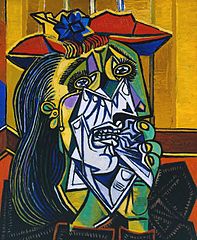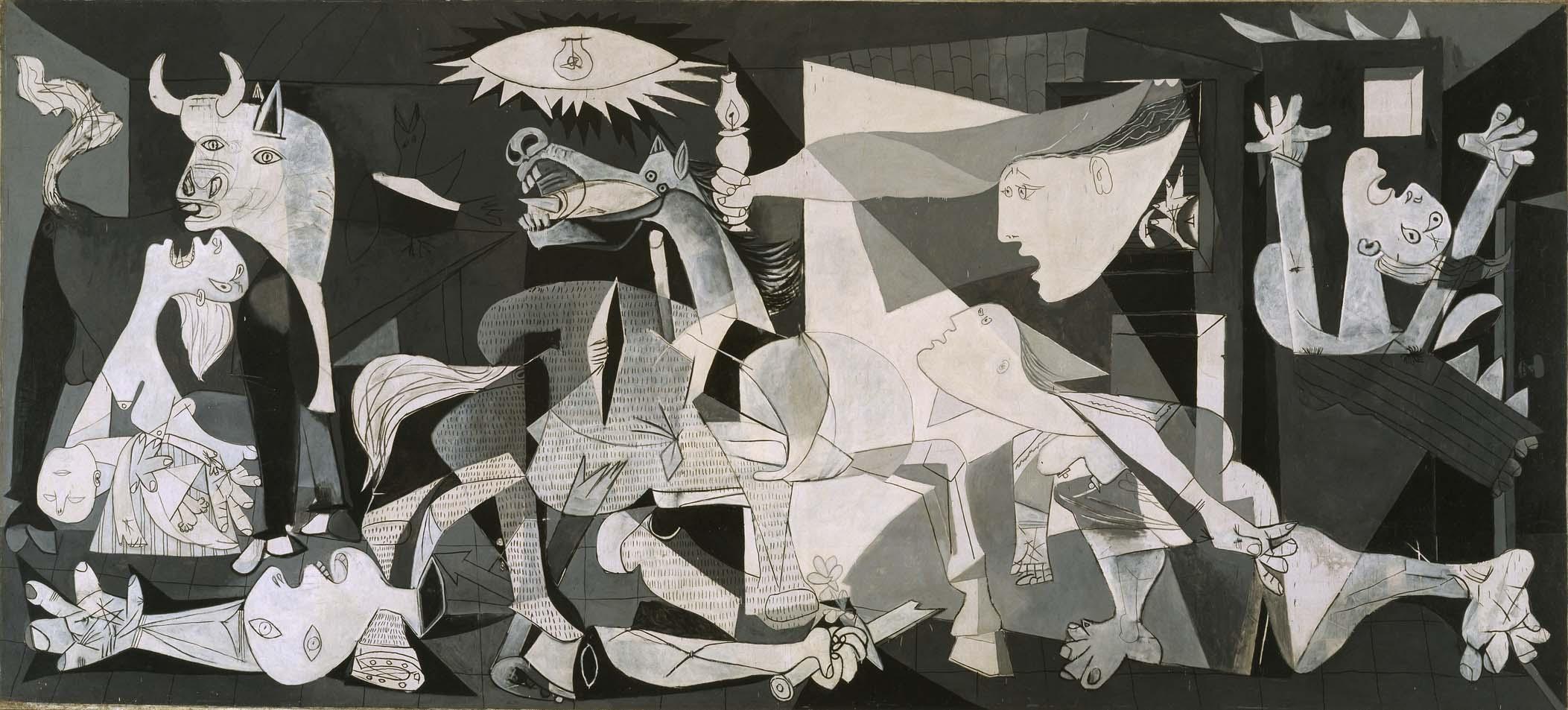Pablo Picasso and his ‘Guernica’
No doubt we all know something about Pablo Picasso. His work is known all over the world and one can contemplate his pieces in many museums from MoMa museum in New York – La señoritas de Avignon (below left) to Tate Modern in London – Weeping woman (below right) as well as in several museums in Spain and other European countries.
Let’s focus now on what we could call the most famous of Picasso paintings. In fact, we should call it a mural due to its huge dimensions. If you have not guessed it yet, we are talking about the Guernica. This picture shows the horror of the Spanish Civil War through the bombing of the Basque town of Guernica (in the north of Spain) by the German air force showing support to Franco´s troops on 26th April 1937, killing hundreds of people. The attackers chose a Monday that was the local market day in Guernica, so they could even maximize the casualties. The attack was against civilians as there were not any military forces in Guernica.
Anyone lucky enough to have contemplated Picasso´s masterpiece will realise there are no bombs or planes. This picture shouts against horror, against massacre, against war. Not only against the Spanish Civil War, or any war in particular, but any kind of war.
Pablo Picasso painted the Guernica for the Spanish Pavilion in the “Exposition Internationale des arts et techniques dans la vie modern” at the Paris International Exposition.
However, the painting did not remain in Paris but was also exhibited in New York, London or Scandinavia.
With his Guernica, Picasso helped to create international awareness of the Spanish Civil War and was also a big step for his own international recognition.
Picasso did not agree with Franco´s regime and he was living in France for a long period of time until his death in 1973 when he was 91 years old. One of the most famous passages about his life is when he was interrogated by the Gestapo while the Nazi occupation in Paris. When the officers saw the Guernica they asked him “Did you paint that?” and he replied “No, you did”
How many of you know in which museum is the Guernica?
Have you seen it? Did you know the story behind it?
Tell us your thoughts!
Vamos Let's Learn Spanish. Spanish courses in London. Spanish courses in Valencia.
Leave a Reply to blouinartinfo1 Cancel Reply
You must be logged in to post a comment.











Really interesting Andrea! Who knows which museum has the Guernica ?
Just a clue – it lives it’s in my hometown and it’s an amazing to experience to see. It is huge! A highly recommended experience!
The art is great in Madrid!
Beautiful painting, just ashamed that our country had to experience a war.
Great post! I have seen Guernica a few times in Madrid at the Reina Sofia Museum. Standing at 3. 5 metres tall and 7.76 metres wide the painting is an experience itself. Full of human and animal symbols like a pigeon, a bull, or a horse there is no doubt this painting is an extraordinary representation of horror and suffering. If you go to Madrid it really is a must see!
Gracias Andrea! 🙂
I have always been fascinated by this painting. It is such a high-quality work of art, with meaning at so many levels! It is a perfect mix between art and history. I read another article time ago and found out so many interesting things about it! http://www.artinsociety.com/the-shocking-birth-and-amazing-career-of-guernica.html
Not only it is a definitive must-see if you go to Madrid, but also a very interesting opportunity to find out more about Spain and its past. Thank you, Andrea, for bringing this story! I learned new things today!
Wow! In just a few words you have explained really good in which context that painting was painted and the huge meaning it still has! Thank you for explaining in a really easy but efficient way a horrific episode of the recent Spanish history. The more we learn about different cultures past, the more we can understand why they think and behave as they do. I hope after reading this post, many people get curious and they will dig a bit more in the topic of Spanish Civil war. Your post induces to that. Thanks!
¡Un artículo muy interesante y muy ameno! En pocas líneas has conseguido describir uno de los episodios más horribles de la historia reciente de España, destacando algunos datos y anécdotas que normalmente pasan inadvertidos o simplemente quedan en el olvido.
Just a really good post! I´m looking forward to read the next chapter!
Amazing post Andrea! Thank you for sharing this with us. I am sure that many readers are now searching on the internet, about Picasso and the Spanish civil war.
The Guernica is my favourite painting, not only because of the quality of this piece of art, but for its historic meaning and because the deaths of all those innocent people should not be forgotten.
What I didn´t know about Picasso, is that he was interrogated by the Gestapo in Paris! I like the way he answer the question: “Did you paint that?”.
Gracias!
There’s also a hidden bulls head in the centre bottom of the painting…can you see it? The base of the head lies on top of a man’s arm.
I love this painting in which Picasso represents the horror of that historic moment. If you would like to practise your Spanish reading a little bit more about the symbols of the Guernica, here you go an interesting analysis:
Análisis de el guernica de picasso from eukenes
Another of my favourites pieces from Picasso is Las Meninas, a series of 58 paintings in which the artist reinterprets and recreates several times Las Meninas by the famous painter Diego Velázquez. Did you know that?
An amazing masterpiece! If you have the opportunity to travel to Madrid, don’t hesitate to visit El Museo Reina Sofía, which is really closed to Atocha, one of the train stations. It used to be free from 19.00 so you can’t miss it!
Well desribed Andrea! It has been years since last time I visited the museum, now you make me feel I have to go again soon. Guernica is such a powerful painting, even if you don’t like art, you will be impressed by this work.
As Montse said, this is a very powerful painting. The colours, the composition, the room, the lights…. everything in that painting has a meaning and a reason to be there. I find reallly interesting the references to the classic culture or other previous paintings. The more you look at El Guernica, the more sense it makes.
If you have the oportunity to go to Madrid and Reina Sofía museum, check it out. The museum is my favourite one of the city and it’s free from 7pm almost every day of the week and sunday all day.
Un articulo muy interesante Andrea. Cuando fui al museo Reina Sofia hace unos anos, ensenaron los dibujos que hizo Picasso para preparar para Guernica. Eran muy interesantes.
Did you know that ” Guernica” was shown at Whitechapel Gallery in East London?
http://www.telegraph.co.uk/culture/art/art-news/5083143/Tapestry-of-Picassos-Guernica-marks-Whitechapel-Gallery-reopening.html
Gracias por este articulo, Andrea. Fui a Madrid el año pasado y vi esta obra en el museo Reina Sofia – no sabía mucho del histórica de esta pintura antes de verlo y estaba muy interesada por el exposición. Su tamaño es impresionante y el sujeto muy serio.
He leído que mucha gente piensan que la pintura debería devolver en el región Basquee – pero no es posible porque el lienzo es demasiado frágil. Al menos es en España ahora, y no todavía en Nuevo York.
Thanks Andrea for a really informative article as I didn’t know about it and also Diana for the article about the symbols. Now I really want to see it for myself. I can also try and impress my friends by pretending to be cultured. 🙂
Muy buen artículo, Andrea – es interesante y educativo. Sólo he visto algunas obras de Picasso aquí en Londres, pero me encantaría ver más en el museo Reina Sofía.
Por ahora hay una exposición de ‘Pop Art’ en Tate Modern y muchas de las obras son de artistas españoles – y reflejan… o son ‘inspiradas’ por la dictadura de Franco. Es buenísima la exposición!
One of my favourite artists of all times!
I love his style and the meaning behind his paintings. It’s amazing what he can describe in his work, probably more and better than what anybody could describe with words!
Like few of you mentioned above, the world is lucky to find his work displayed all over the globe. There’s also a great selection of his paintings at the Museo Picasso Málaga in his home town, Málaga:
http://www.museopicassomalaga.org/
I have visited it and it’s really worth the visit!
About his “Guernica”, what can we say? It’s truly a masterpiece and one of the “must see” paitings that anybody would be impressed to contemplate! 🙂
Gracias Andrea!
Good one!!
Claro ejemplo de cómo la historia y el arte van de la mano
Imposible haber creado esta obra de arte sin el horror y los sentimientos que mueve una guerra.
Very interesting article with the axes on Picasso´s life to show us social and art at the same time with the rythem of your writing! NIce!!!
Wow Great Post by author Pablo Picasso you can visit here for best Pablo Picasso.